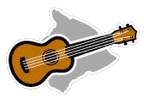Lots of you use shellac for various purposes and I’d like to hear more about that. I’m enamored with shellac, and freely use it in many ways. Unlike Woodley, Terry, Doug, and probably Dave, I don’t use it for French polish. I use it at many stages of construction to protect the wood from glue stains and dings. I also use it as a base coat for my lacquer finishes and and as a finish aid on my fretboards and bridges.
During construction I apply shellac to the outside of the top and back while I’m doing the bracing. When the box is closed I sand the body thoroughly and apply it again to the top, back, and sides before doing the binding. I used to use lacquer for that, but shellac is so much easier and user friendly. Before starting the finish I also wipe on a coat to the completely sanded body. I use solvent base finishes, so I have no idea if this would work with waterbase.
I normally use what is called a 2# cut. Making my own by mixing up shellac flakes and alcohol makes me feel like I’m a real luthier! The flakes come in various color hues, but for thin coats like I use, I don’t think it matters. I get my flakes from Shellac Shack in Portland. If you don’t know how to make shellac, both Stew-Mac and Shellac Shack send directions with your order.The alcohol comes from Kadota Liquors in Hilo, although a visitor to my shop recently told me his cousin makes his own. Not for making shellac I suspect! A 2# cut is very thin bodied and easy to apply by wiping it on. Shellac, once mixed, has a short shelf life. I make it in very small quantities, store it in glass, and keep a squeeze bottle handy on my bench because I use it almost everyday. I date it and never keep it longer than 90 days. I would be interested in hearing how some of you may be using shellac. Happy building and have a great Holiday Season too.—Bob G.
Bob Gleason
I use the same mix and solvent as you do, Bob. I learned to French Polish on my first guitar in 1992 and I used it exclusively for the first hundred guitars I built. I took lessons in applying French Polish from Cyndy Burton, Eugene Clark, Olivier Fandon d’Andon and Geza Burghardt. To French Polish a guitar, it pretty well takes me a month. I apply F.P. each morning and evening until I have enough finish and then I level with 1000 grit paper or pumice and a felt block. Then I put on finish coats where I thin the two pound cut. Then I buff it by hand with mirror glaze or something similar. I never use a power buffer on French Polish. It is very thin and consequently, great sounding.
After moving to Hawaii, I pretty well migrated to lacquer and have done over 200 ukuleles and guitars with lacquer. I primarily use shellac to seal the rosette channels and binding rebates on spruce, cedar and redwood. You can use other alcohols but I prefer the 190 proof grain alcohol. Then it’s a completely non toxic finish. You could lick your fingers. Bob Ruck taught me to mix in lacquer in the F.P., which I have tried. He also swore by Kukui nut oil as a lubricant. I normally use walnut oil to prevent a sticky pad but I try to use very little oil. A little oil helps prevent crazing and cracking on the purfling lines. I don’t throw out my finish every 90 days. I keep it until the finish stops acting right. The flakes have a shelf life as well. I buy my shellac flakes (bleached blonde) from Shellac Shack in Oregon. I’m doing two classical guitars right now where I’m using French Polish on the top and lacquer on the back and sides.
As you know, French Polish is the standard for high end classical guitars. I also use shellac on spruce and cedar tops to harden the wood to make clean cuts with the router. I have a bottle on my bench and squirt bottle of alcohol. I typically fill hardwood pores with epoxy after a seal coat of shellac and then sand back to the wood before building the shellac finish. Thanks for getting us to think about this.
Woodley Whiite
